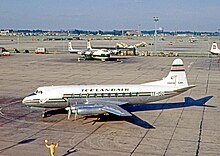Sweden and Iceland.....a book series about a super star computer scientist......investigator in Sweden....a woman.....the 1st in the series is The Girl With the Dragon Tattoo....
History[edit]
Flugfélag Íslands in the early decades[edit]
Icelandair traces its roots back to 1937, when Flugfélag Akureyrar was founded in Akureyri on the north coast of Iceland. Flight operations started in 1938 with a single floatplane of the type Waco YKS-7. In 1939 the airline was grounded when this aircraft was destroyed in a capsizing accident. The company moved to Reykjavík, where it acquired another Waco aircraft and was re-launched in 1940 as Flugfélag Íslands, which translates as Flight Company of Iceland.[5] Previously, two unrelated airlines of the same name had existed in the country (from 1919 to 1920, and between 1928 and 1931).[6] For international purposes, the name Iceland Airways was adopted.[7]
The fleet was expanded with a Beechcraft Model 18 in 1942, and with two de Havilland Dragon Rapide[8] as well as one U.S.-made Consolidated PBY Catalina in 1944, the latter being the first ever aircraft registered in Iceland to be flown to Iceland by an Icelandic crew from North America.[9] On 11 July 1945, this aircraft operated the first commercial flight over the Atlantic Ocean for the airline, which led from Reykjavík to Largs in Scotland, with four passengers and four crew members on board. Regular flights to Prestwick Airport, Scotland and Copenhagen in Denmark, using B-24 Liberator aircraft leased from Scottish Airlines were launched in 1946.[6]
In the same year, comfort and performance of domestic flights in Iceland could be improved with the introduction of the Douglas DC-3 Dakota. A total of six airliners of that type had been purchased, which remained in service with the airline until 1972, the oldest one being still flightworthy as of 2011.[10] Until the late 1960s, Flugfélag concentrated mostly on domestic flights, where it initially faced fierce competition from Loftleiðir, another airline which had been founded in 1944. When a merger proposal of the Icelandic government was rejected by the two airlines, the domestic routes were split among them as a measure to ease competition. When Loftleiðir pulled out of the domestic market in 1952 to fully concentrate on international flights, Flugfélag became the main domestic carrier of the country.
International services stayed part of the business model of Flugfélag, though to a far lesser extent compared to Loftleiðir. In 1948, the Douglas C-54 Skymaster was introduced on those routes, and in 1957 two new Vickers 759 Viscounts were acquired, the first turboprop airliners to be operated by an Icelandic airline. In the 1950s, Flugfélag began to use the Icelandair branding for its international flights.[7]
In 1967, Flugfélag was the first Icelandic airline to join the jet age, when a Boeing 727-100 dubbed Gullfaxi was put into service.[11]Another 727 was acquired in 1971, and the aircraft type was operated until 1990.[12] In 2008, the cockpit section of the Gullfaxi was put on display at the Akureyri Aviation Museum.[13


Comments
Post a Comment